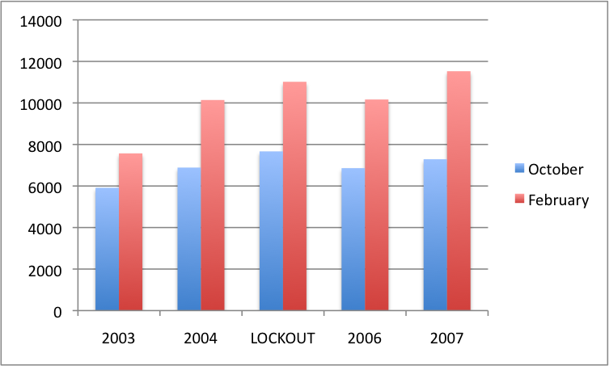The effect of the NHL lockout on CHL attendance in NHL cities
The Edmonton Oil Kings are in a very good position for establishing themselves. Not only are they coming off a WHL Championship, which heightened their presence in the Edmonton market, but there's a pretty big chance that their main competition for high-level hockey in the area, the Oilers, may not start the season on time.
Of course, Daryl Katz and Rexall Sports own both the Oilers and the Oil Kings, but there's a signifiant chance that both teams could be more visible in the community if there's a prolonged NHL lockout. For those unawares, the National Hockey League has yet to extend a Collective Bargaining Agreement with their Player's Association past September 15. Should a deal not be signed, the NHL owners will likely lock the players out, prompting a work stoppage like in the 2004-2005 season.
I wanted to see exactly how this affected attendance for teams that share a market with a CHL franchise. The Vancouver Giants, Calgary Hitmen and Ottawa 67s are all big-market staples of their leagues. But was there a spike in attendance in the lockout year? Is there an opportunity for junior clubs to go out and really establish themselves? It helps the Oil Kings and perhaps the Mississauga Steelheads.
Chances are, there will be a lockout. But what are the effects on attendance?
Of course, we don't have merchandise sales, and there is a lot of problems with these numbers. But basically I looked at average team attendance for the Hitmen, 67s and Giants in October and February for the lockout season and the two years before and after. Part of why this is problematic is that some months offer a pretty small sample of games to work with, but I wanted to get a gauge on fan interest at the start, and midway through the season.
The Giants were WHL Champions in 2006 and hosted the Memorial Cup in 2007 after being a relatively new franchise in 2001. Still, the team was second in the Western Conference in 2004, yet it wasn't until the NHL lockout that the Giants really became a force:
The first thing I noticed is that fans were far more prevalent in each junior rink in February than in October. You can see the average attendance jumps for the lockout year, takes a slight dip the next year, but then improves as the Giants became the clear WHL and Memorial Cup favourites. I wonder what the attendance would have been like sans lockout.
Again, this isn't a perfect method. The Giants play out at the Pacific Coliseum which is quite far from downtown and they have a different customer base to draw from.
Here are the Calgary Hitmen:
Same sort of thing, really. The Hitmen improved from 2003 through 2005, but then dipped in 2006 before peaking in 2007. Side-note, the Calgary Flames selected a defenceman in the 2003 draft named Dion Phaneuf. During February of 2005, 16,388 fans came out to watch the Hitmen take on Phaneuf's Red Deer Rebels.
For the Ottawa 67s:
Slight, slight increases from 2003 to 2005 mid-season, but a drop at the start of the season. The Senators were a very exciting team in 2006 and 2007, leading the league in goals the first year and making the Cup Finals the second. They didn't terrifically improve in attendance thanks to the lockout, but they were more established in the market before the lockout.
Like Vancouver, the 67s and Sens play in a different building, although the 67s are closer to downtown than the Senators, who play in nearby Kanata.
As for total percentage of attendance, with the high point being the maximum found in each building over the sample, here's how it breaks down:
The spike in 2005 in Calgary and Vancouver really affects the final graph, and over the five years. October of 2004 saw more fans in these rinks than October in 2002, 2003, 2005 or 2006, but February in 2007 was slightly better overall.
I think we can say that the Giants, Hitmen, 67s and Oil Kings are going to have a pretty good October. Each team has developed their own culture in their city separate from the NHL fans, and all a lockout will do for junior hockey is ensure that some of the top 19-year olds will stay with their junior club and fans who would normally watch the NHL would come out to watch the CHL instead. And, as 2006 was a better year than 2004 for these teams, you have to think that a few of them may stick around once hockey does return...
The other thing to consider is that exposure may increase. During the last lockout year, it was also the last junior season of one Sidney Crosby. Another future NHL star in the "Q", Nathan MacKinnon, may also increase the appetite of some junior fans as MacKinnon heads into his draft year.

 Yahoo Sports
Yahoo Sports 






